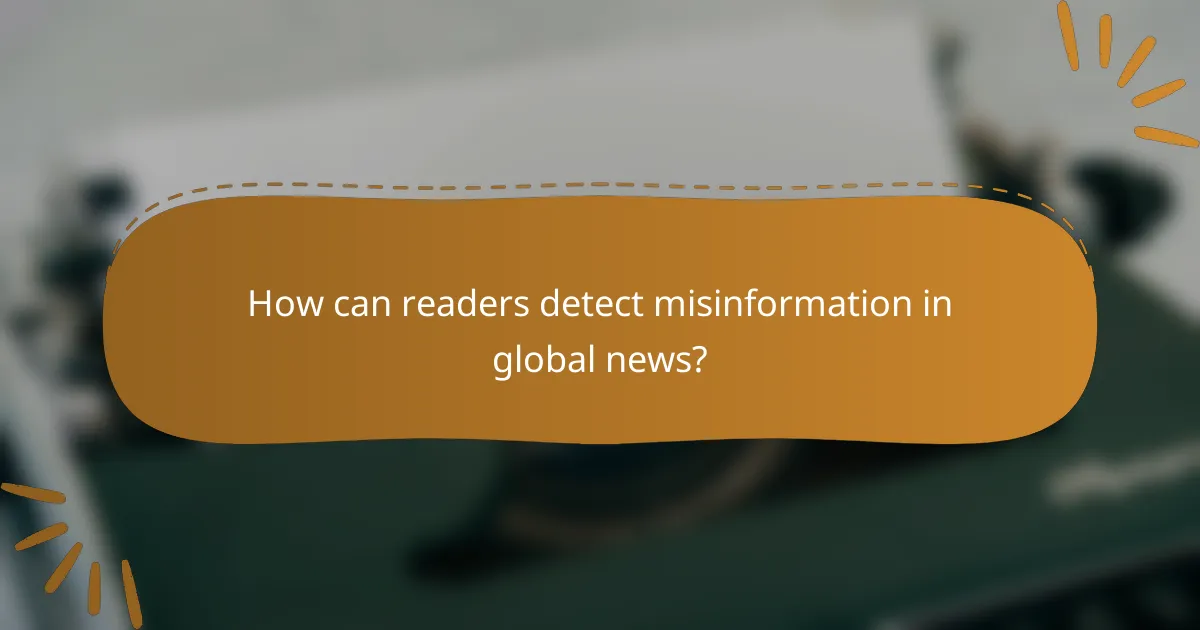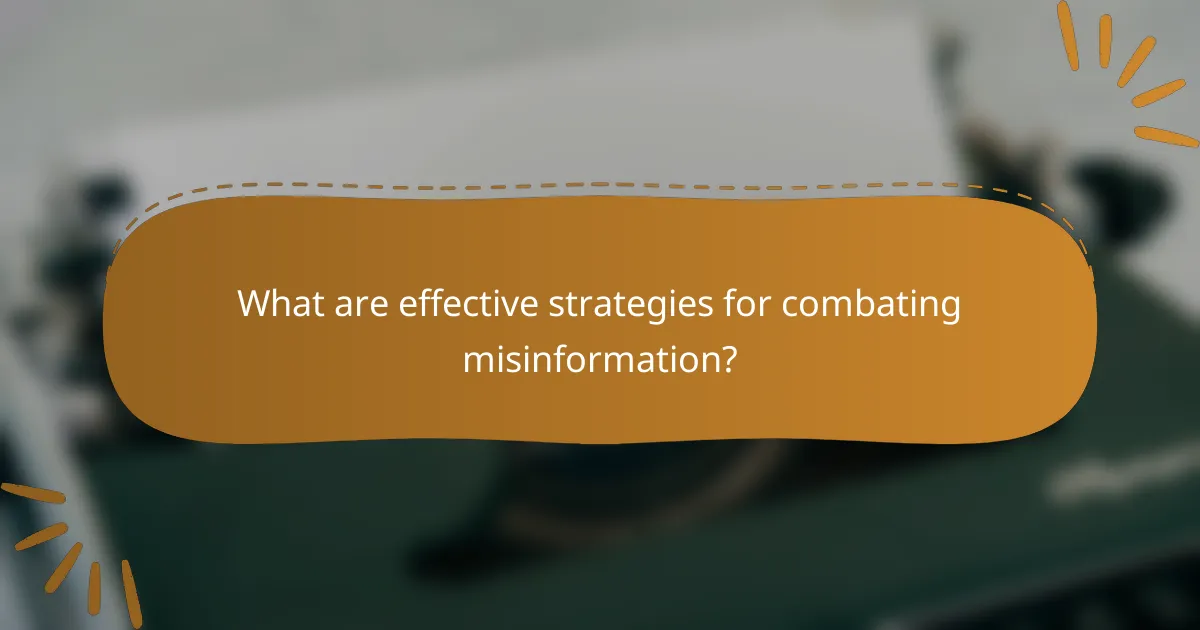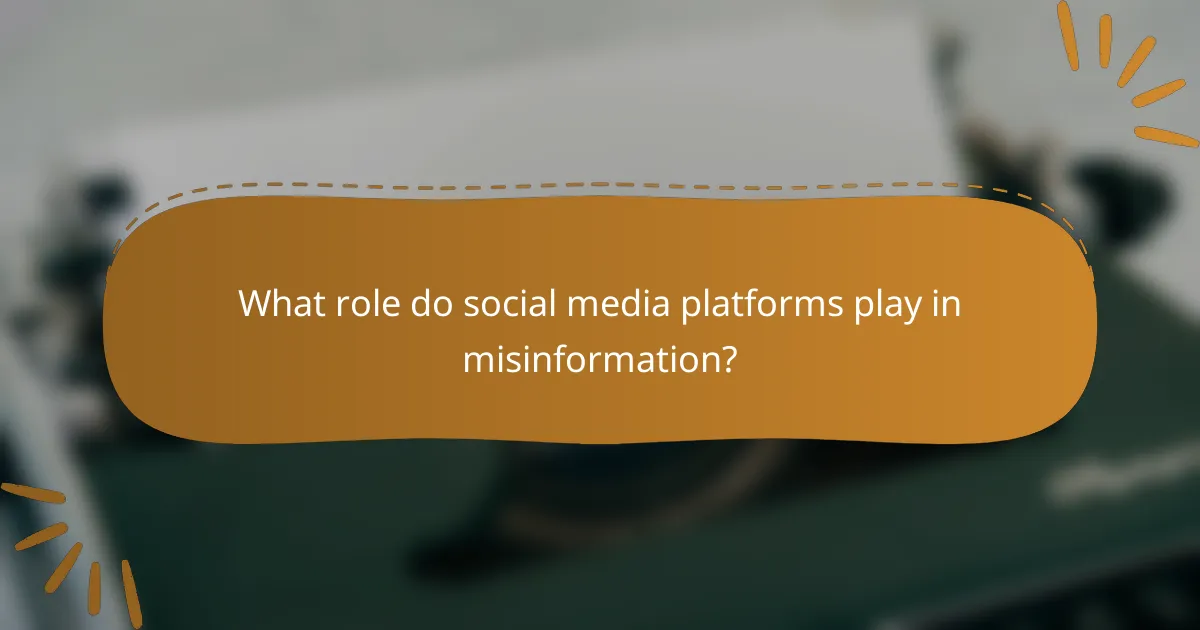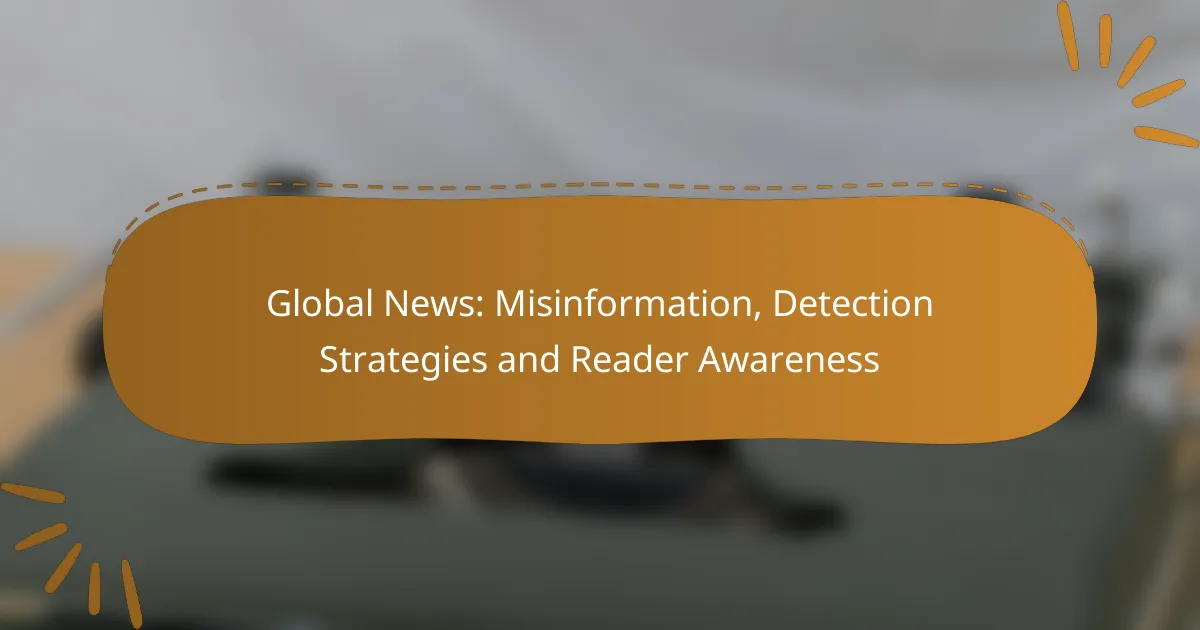Misinformation in global news poses a significant challenge, distorting public perception and shaping beliefs based on false narratives. To combat this issue, readers can enhance their critical thinking skills through various detection strategies, such as utilizing fact-checking websites and participating in media literacy programs. By fostering community engagement and promoting educational campaigns, we can collectively raise awareness and empower individuals to navigate the complex landscape of information more effectively.

How can readers detect misinformation in global news?
Readers can detect misinformation in global news by employing various strategies that enhance their critical thinking and analytical skills. These methods include utilizing fact-checking websites, participating in media literacy programs, cross-referencing sources, identifying biased language, and using verification tools.
Fact-checking websites
Fact-checking websites are valuable resources for verifying the accuracy of news stories and claims. Platforms like Snopes, FactCheck.org, and PolitiFact assess the truthfulness of statements made in the media and provide detailed analyses. Readers should regularly consult these sites when encountering dubious information.
When using fact-checking websites, look for clear citations and evidence that support their conclusions. This transparency helps ensure that the information is reliable and well-founded.
Media literacy programs
Media literacy programs educate individuals on how to critically evaluate news sources and content. These programs often cover topics such as recognizing bias, understanding media ownership, and analyzing the intent behind news reporting. Engaging in such programs can significantly enhance a reader’s ability to discern credible information.
Many libraries, schools, and community organizations offer media literacy workshops. Participating in these can empower readers to navigate the complex media landscape more effectively.
Cross-referencing sources
Cross-referencing sources involves checking multiple outlets to confirm the accuracy of a news story. By comparing reports from different reputable news organizations, readers can identify discrepancies and gain a fuller understanding of the issue at hand. This practice is crucial for spotting misinformation.
When cross-referencing, prioritize established news organizations known for their journalistic standards. If several credible sources report the same information, it is more likely to be accurate.
Identifying biased language
Identifying biased language helps readers recognize when news is presented with a particular slant or agenda. Words that evoke strong emotions or loaded terms can indicate bias. Being aware of this language allows readers to approach the content with a critical mindset.
To spot biased language, pay attention to adjectives and adverbs that seem exaggerated or emotionally charged. A neutral report should present facts without sensationalism or overt opinions.
Using verification tools
Verification tools assist readers in assessing the authenticity of images, videos, and claims made in news articles. Tools like Google Reverse Image Search and TinEye can help determine if an image has been manipulated or taken out of context. These resources are essential for verifying visual content.
Additionally, browser extensions like NewsGuard can evaluate the credibility of news websites. Using these tools can help readers make informed decisions about the information they consume.

What are effective strategies for combating misinformation?
Effective strategies for combating misinformation include community engagement, collaboration with technology platforms, and educational campaigns. These approaches work together to enhance public awareness and promote critical thinking skills among readers.
Community engagement initiatives
Community engagement initiatives focus on fostering dialogue and collaboration among local groups to address misinformation. These initiatives can include town hall meetings, workshops, and social media campaigns that encourage residents to discuss and verify information collectively.
For instance, local organizations can host events where experts explain how to identify misinformation and share tools for fact-checking. Engaging community leaders can also help amplify these efforts, ensuring that accurate information reaches a wider audience.
Collaboration with tech platforms
Collaboration with tech platforms is crucial for effectively combating misinformation online. Social media companies and search engines can implement algorithms and tools that flag or reduce the visibility of false information while promoting credible sources.
For example, platforms can partner with fact-checking organizations to provide users with context and verification options for trending topics. Additionally, transparency in how content is moderated can build trust among users and encourage them to rely on verified information.
Educational campaigns
Educational campaigns aim to equip individuals with the skills needed to discern credible information from misinformation. These campaigns can be implemented in schools, workplaces, and online, focusing on critical thinking and media literacy.
Programs may include interactive workshops, online courses, or resource guides that teach users how to evaluate sources, recognize bias, and understand the impact of misinformation. Regularly updating these materials to reflect current trends and technologies is essential for maintaining their relevance and effectiveness.

How does misinformation impact public perception?
Misinformation significantly distorts public perception by shaping beliefs and attitudes based on false or misleading information. This can lead to misguided decisions and polarized viewpoints across various societal issues.
Influence on political views
Misinformation plays a crucial role in shaping political views by spreading false narratives that can sway public opinion. For instance, misleading claims about political candidates can create distrust and alter voter behavior, especially during election cycles.
Social media platforms often amplify these falsehoods, making it essential for readers to critically evaluate sources before forming political opinions. Engaging with verified information can help mitigate the impact of misinformation on political beliefs.
Effects on public health
The spread of misinformation can have dire consequences for public health, particularly during health crises like pandemics. False information about vaccines or treatments can lead to decreased vaccination rates and increased illness, affecting community health outcomes.
To combat this, health organizations emphasize the importance of relying on credible sources for health information. Individuals should verify claims through trusted medical institutions to avoid the pitfalls of misinformation.
Shaping social narratives
Misinformation shapes social narratives by influencing how communities perceive issues such as climate change, immigration, and social justice. Misleading stories can create division and foster stereotypes, impacting societal cohesion.
To counteract these effects, it is vital for individuals to engage in discussions that promote fact-checking and critical thinking. Sharing accurate information can help build a more informed society and challenge harmful narratives.

What role do social media platforms play in misinformation?
Social media platforms significantly contribute to the spread of misinformation by facilitating rapid sharing and engagement. Their design encourages users to interact with content, which can amplify false information and create echo chambers that reinforce misleading narratives.
Algorithmic amplification
Social media algorithms prioritize engaging content, often promoting posts that generate high interaction rates, regardless of their accuracy. This can lead to the widespread dissemination of sensational or misleading information, as users are more likely to share content that evokes strong emotional responses.
For instance, a post containing shocking claims may receive more likes and shares, causing it to appear more frequently in users’ feeds. This amplification can distort public perception and make it challenging for accurate information to gain visibility.
Content moderation policies
Content moderation policies vary widely across platforms, influencing how misinformation is addressed. Some platforms employ automated systems to flag or remove false content, while others rely on user reports and human moderators.
However, these policies can be inconsistent, leading to criticism over biased enforcement or insufficient action against harmful misinformation. Users should familiarize themselves with the specific moderation practices of each platform to understand how misinformation is managed.
Partnerships with fact-checkers
Many social media platforms have established partnerships with independent fact-checkers to assess the accuracy of shared content. These collaborations aim to identify and label misleading information, providing users with context and encouraging critical evaluation.
While these partnerships can enhance the reliability of information, their effectiveness depends on user engagement. Users are encouraged to check for fact-check labels and consider the credibility of sources before sharing content to combat misinformation actively.

What are the key characteristics of credible news sources?
Credible news sources are distinguished by their commitment to accuracy, transparency, and accountability. They provide well-researched information, clearly attribute their sources, and maintain a track record of reliability.
Transparency in reporting
Transparency in reporting involves disclosing sources, methodologies, and potential conflicts of interest. Credible news outlets often provide citations and links to original documents or studies, allowing readers to verify claims independently.
For example, a news article discussing a scientific study should include a link to the study itself. This practice not only builds trust but also empowers readers to explore the information further.
Expertise of journalists
The expertise of journalists is crucial for credible news reporting. Journalists with specialized knowledge or experience in a particular field can provide deeper insights and context, which enhances the quality of the news presented.
For instance, a journalist covering healthcare should ideally have a background in medicine or public health. This expertise helps ensure that the information is accurate and comprehensible, reducing the risk of misinformation.
Accountability measures
Accountability measures are essential for maintaining credibility in news reporting. Reputable news organizations often have editorial standards and fact-checking processes in place to ensure the accuracy of their content.
Additionally, they may issue corrections or clarifications when errors occur, demonstrating a commitment to honesty. Readers should look for news sources that openly address mistakes and take steps to rectify them, as this reflects a strong ethical foundation.

How can governments address misinformation on a global scale?
Governments can tackle misinformation through a combination of regulatory frameworks, public awareness campaigns, and collaboration with tech companies. By implementing effective legislation and promoting media literacy, they can create an environment that discourages the spread of false information.
Legislation on false information
Legislation targeting false information involves creating laws that define and penalize the spread of misinformation. Governments may establish clear guidelines on what constitutes false information and the consequences for individuals or organizations that disseminate it.
For example, some countries have enacted laws that impose fines or even imprisonment for spreading false news during elections or public health crises. These laws aim to deter malicious actors while balancing the need for freedom of expression.
However, governments must be cautious to avoid overreach, ensuring that legislation does not infringe on civil liberties. Effective laws should include provisions for transparency and accountability, allowing for public scrutiny of enforcement actions.
